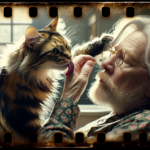Contents
The Hair-Licking Habit: Insights into Your Cat’s Behavior
Understanding Your Cat’s Hair-Licking Habit
As a cat lover, you may have noticed your feline friend engaging in a peculiar behavior: hair licking. While it may seem strange or even worrisome, it’s actually quite common among cats. In this article, we’ll delve into the reasons behind this behavior and provide insights into your cat’s behavior.
Reasons Behind Hair Licking
There are several reasons why cats indulge in hair licking:
- Grooming: Cats are meticulous groomers, and licking their fur is an important part of their grooming routine. Hair licking helps them to keep their coat clean and free from tangles.
- Comfort: Some cats find comfort in grooming behaviors, including hair licking. It can be a self-soothing activity for them, especially during times of stress or anxiety.
- Social Bonding: Cats that live together often engage in mutual grooming, including hair licking. This behavior helps to strengthen social bonds between them, promoting a sense of belonging and security within their group.
When Hair Licking Becomes a Problem
While hair licking is generally harmless, excessive or compulsive licking can lead to issues such as:
- Hairballs: Excessive swallowing of fur during grooming can result in the formation of hairballs in your cat’s digestive system, causing discomfort and potential health issues.
- Skin Irritation: Constant licking can irritate your cat’s skin, leading to redness, inflammation, and potential infections.
Managing Your Cat’s Hair-Licking Habit
If your cat’s hair licking becomes a concern, there are several steps you can take to manage the behavior:
- Regular Brushing: Help your cat maintain a healthy coat by regularly brushing them. This will reduce the amount of loose fur that they ingest during grooming.
- Toys and Distractions: Provide your cat with interactive toys and puzzles to keep them mentally stimulated and distracted from excessive grooming behaviors.
- Consulting a Veterinarian: If your cat’s hair licking becomes compulsive or is accompanied by other concerning symptoms, it’s important to consult with a veterinarian. They can rule out any underlying health issues and provide advice on managing the behavior.
Understanding your cat’s hair-licking habit is essential for providing them with the best possible care. Recognizing the reasons behind this behavior and taking appropriate measures to manage it will ensure that your feline friend remains healthy and happy.
Understanding the Bond: What Does It Mean?
When it comes to our relationships with animals, there is often a special bond that goes beyond words. Whether it’s a loyal dog or a playful cat, these creatures have a way of connecting with us on a deeper level. But what does this bond really mean? In this article, we will explore the significance of the bond between humans and animals, and how it can enrich our lives.
The Power of Companionship
One of the key aspects of the bond between humans and animals is the power of companionship. For many people, having a pet provides a sense of comfort and emotional support. Pets are there to listen, to cuddle, and to be a constant presence in our lives. They offer unconditional love and provide a shoulder to lean on during times of distress. This companionship can help reduce stress and anxiety, and even improve mental well-being.
Emotional Connection
Animals have a unique ability to understand and connect with humans on an emotional level. They can sense when we’re happy, sad, or in need of comfort. Dogs, for example, are known for their empathy and can even detect changes in our body language and tone of voice. This emotional connection can be incredibly healing and can help create a sense of belonging and purpose in our lives.
Nurturing and Responsibility
Caring for an animal also brings a sense of nurturing and responsibility. When we take on the role of a pet owner, we must provide for their needs, including food, shelter, and exercise. This responsibility teaches us valuable life lessons about compassion, patience, and the importance of selflessness. Through the bond with our pets, we learn to put their needs before our own and develop a sense of purpose in caring for another living being.
The Healing Power of Animals
Studies have shown that interacting with animals can have a positive impact on our well-being. Therapy animals, for instance, are used in various settings to help individuals cope with physical and emotional challenges. The presence of animals can reduce feelings of loneliness, lower blood pressure, and even improve cardiovascular health. Their calming effect can help decrease stress levels and promote a sense of relaxation and happiness.
The bond between humans and animals is a powerful and meaningful connection. It goes beyond words and reaches into the depths of our hearts. Through companionship, emotional connection, nurturing, and healing, our relationships with animals bring joy, love, and purpose to our lives. So let’s cherish and appreciate this bond and continue to nurture our connections with the incredible creatures we share our world with.
Psychological Motives behind Hair-Licking
Hair-licking, a seemingly uncommon behavior, is not only intriguing but also raises questions about the psychological motives behind it. In this article, we will explore the various reasons people engage in hair-licking and the underlying psychological factors that contribute to this behavior.
1. Oral Fixation
One psychological motive behind hair-licking is related to the concept of oral fixation. Hair-licking may serve as a form of oral stimulation, providing comfort and satisfaction. Individuals who engage in hair-licking might do so as a way to reduce anxiety or stress, similar to how some people bite their nails or chew on pens.
2. Sensory Stimulation
Hair-licking can also be driven by sensory stimulation. The act of running one’s tongue through the hair can provide a unique texture and sensation. This sensory experience may be pleasurable for individuals who engage in hair-licking, leading them to repeat the behavior as a means of seeking sensory gratification.
3. Self-Soothing Mechanism
Hair-licking can function as a self-soothing mechanism for individuals who struggle with regulating their emotions. By engaging in this behavior, they can create a sense of calmness and relaxation. It may serve as a coping mechanism to manage overwhelming emotions or as a way to regulate emotional distress.
4. Attention-Seeking Behavior
In some cases, hair-licking can be a form of attention-seeking behavior. People who engage in this behavior may do so to draw attention to themselves or to elicit a reaction from others. This motive is often seen in children seeking attention from their parents or peers.
5. Habitual Behavior
Lastly, hair-licking can become a habitual behavior, similar to other repetitive habits such as nail-biting or hair-twirling. Individuals may engage in hair-licking without a specific motive, but rather out of habit or as a reflex. Breaking this habit can be challenging, requiring conscious effort and behavioral modifications.
While hair-licking may seem like an unusual behavior, it can be influenced by various psychological motives. From oral fixation and sensory stimulation to self-soothing mechanisms and attention-seeking behavior, understanding the underlying psychological factors behind hair-licking can shed light on why individuals engage in such behavior. Remember, if hair-licking becomes excessive or interferes with daily functioning, it is important to seek professional help to address the underlying psychological issues.
Nurturing the Bond: Ways to Enhance Your Relationship
1. Communication is Key
A strong and healthy relationship is built on effective communication. Make it a priority to communicate openly and honestly with your partner. Remember to actively listen and validate their feelings. Regularly check in with each other to discuss any concerns or issues that may arise.
2. Quality Time Together
In our busy lives, it’s important to carve out dedicated time for your relationship. Whether it’s a date night, a weekend getaway, or simply enjoying a quiet evening at home, make sure to prioritize quality time together. Disconnect from technology and fully engage with each other.
3. Show Appreciation
Expressing gratitude and showing appreciation for your partner is a simple yet powerful way to enhance your bond. Take the time to notice and acknowledge the little things they do for you. A heartfelt “thank you” or a surprise gesture of kindness can go a long way.
Discover and participate in activities that you both enjoy. Whether it’s cooking, hiking, painting, or watching movies, finding common interests will bring you closer together. Engaging in shared activities strengthens your bond and creates positive experiences.
5. Keep the Romance Alive
Don’t let the spark fade away in your relationship. Surprise your partner with small gestures of romance, such as leaving them a love note or planning a surprise date. Keep the passion alive by regularly expressing your love and desire for each other.
6. Support Each Other’s Dreams
Encourage and support your partner’s dreams and aspirations. Be their biggest cheerleader and help them achieve their goals. Celebrate their successes and offer a shoulder to lean on during challenging times. A strong support system boosts the bond between you.
7. Resolve Conflicts Constructively
Conflict is a normal part of any relationship. The key is to resolve conflicts in a healthy and constructive manner. Practice active listening, validate each other’s perspectives, and find compromise. Remember, it’s not about winning an argument, but about finding solutions together.
8. Keep Growing Together
Embrace personal growth and encourage your partner to do the same. Set individual and shared goals and work towards them together. Continuously learn from each other and strive to become the best versions of yourselves, both as individuals and as a couple.
Nurturing and enhancing your relationship takes effort and dedication. By prioritizing effective communication, quality time, and constant support, you can strengthen the bond with your partner. Embrace shared interests, keep romance alive, and resolve conflicts constructively. Together, you can grow, thrive, and create a lasting and fulfilling relationship.




